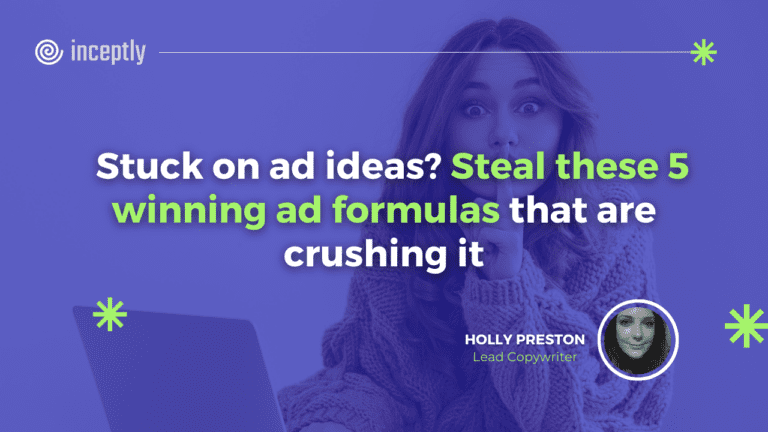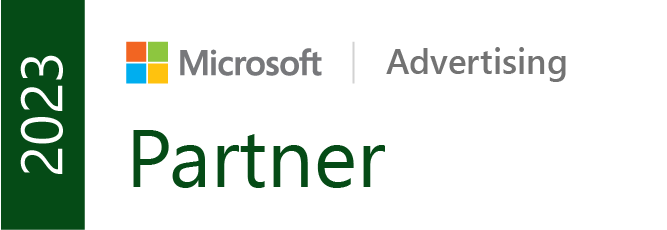
Let’s be honest—sometimes, we run out of ideas.
Creative fatigue is real. We can stare at the screen, trying to come up with the next big idea, but nothing sticks. So, what do we do?
Instead of throwing BEEP at the wall and hoping something works, we can look at what’s already working.
📌 Successful ads leave clues. If a brand is spending millions on a single ad, chances are it’s converting like crazy. Instead of reinventing the wheel, we can study these ads, break them down, and use the proven formulas to craft our own high-performing campaigns.
This isn’t about copying word-for-word—that never works. Context is key. You need to understand:
✔️ Your product – What makes it unique?
✔️ Your audience – What are their pain points and desires?
✔️ Your messaging – How do you frame it to resonate?
Want to brainstorm with our team on new ways to scale your business with YouTube Ads (and other performance video platforms)?
Join us for a free YouTube ad brainstorming session👇
How to find winning ads & save your best ideas
1️⃣ Save any ad or creative that grabs your attention
If an ad makes you watch the whole thing, click, or even want to buy—save it. I have a personal swipe file where I keep YouTube ads, Instagram ads, and Facebook creatives that stand out. I save ads in folders on YouTube, track winners on VidTao, and screenshot anything interesting on Instagram.
2️⃣ Use Glasp
This is a great free Chrome extension that lets you transcribe any YouTube ad. I use it every day to grab transcripts of high-performing ads so I can analyze the copy line by line. If you’re serious about breaking down winning ad formulas, I highly recommend it.
3️⃣ Check high-spending ads
Use VidTao, Facebook Ad Library, and TikTok Ad Library to see what brands are spending big on. If an ad has been running for months with high ad spend, it’s probably converting.
4️⃣ Build your own creative “think tank”
You need a personal scrapbook of inspiration. Save anything that fires you up, makes you stop scrolling, or makes you think “That was brilliant.” Any small detail—a hook, a visual, a CTA, a pacing style—could spark your next winning idea.
5️⃣ Break them down strategically
Don’t just watch ads—dissect them. Look at:
✔️ The hook – How do they grab attention?
✔️ The structure – How does the message flow?
✔️ The persuasion tactics – What emotional triggers do they use?
✔️ The CTA – How do they drive action?
And most importantly—apply these insights to YOUR product. It’s not about copying. It’s about understanding what works and adapting it to fit your product, audience, and unique selling proposition.
To show you how this works, I’ve broken down 5 high-performing direct-response ads that are crushing it right now. Each one teaches a different lesson in copywriting, persuasion, and ad strategy.
Let’s get into it. 🚀
1. ClickUp - "The Firing of Jira"
🔍 The big lesson: Storytelling + humor to highlight pain points
📌 What’s the ad about?
ClickUp turns a dry, functional software comparison into a memorable, entertaining, and relatable ad. Instead of a boring list of features, they create a skit where Jira is treated like an underperforming employee who’s being fired. This gives the ad a narrative structure that keeps people engaged while naturally positioning ClickUp as the superior alternative.
By personifying Jira as a difficult coworker, the ad makes complex software frustrations tangible—something users can immediately relate to. It also leverages humor, contrast, and storytelling to turn an ordinary SaaS ad into something people actually want to watch.
📖 Ad breakdown: Structure & copy formula
✅ Hook (First 5 seconds):
“We brought you here today to let you know that we made the business decision to switch to ClickUp.”
Why it works: Instantly intriguing—drops the viewer into a scenario mid-action, sparking curiosity.
✅ Problem/agitation:
Lists real pain points Jira users experience (slow, outdated, costly, poor customer support).
Delivered in dialogue format rather than a salesy monologue, making it conversational and engaging.
✅ Contrast + solution:
“ClickUp just handles our workload more easily and can do way more.”
This line directly contrasts ClickUp’s strengths with Jira’s weaknesses, making ClickUp feel like a no-brainer upgrade.
✅ CTA (final seconds):
“Bring your epics, stories, and sprints to ClickUp. Free forever.”
The “free forever” incentive removes objections and makes the switch feel effortless.
🚀 Key takeaways & how to apply this formula
🔥 Use storytelling to demonstrate pain points instead of just listing them.
🔥 Contrast is key – highlight the “old way” vs. the “new way” to make switching feel obvious.
🔥 A frictionless CTA (like “free forever”) eliminates hesitation and boosts conversions.
2. BetterHelp - "You're Sitting At Home, Alone, Watching YouTube Videos"
🔍 The big lesson: Emotion-driven, soft-sell ads work
📌 What’s the ad about?
This ad doesn’t feel like an ad. It’s shot in a simple, intimate setting with a guy casually talking about feeling lost in life. The ad doesn’t immediately pitch therapy—instead, it focuses on emotional struggles people can relate to, making the message deeply personal.
BetterHelp frames the problem first, allowing viewers to connect before presenting therapy as the solution. The conversational tone makes it feel like a real moment, not a scripted ad.
📖 Ad breakdown: Structure & copy formula
✅ Hook (first 5 seconds):
“What do you want?”
Why it works: The simple question draws in the viewer immediately. The subtle approach doesn’t immediately feel like a pitch—it feels like a genuine conversation.
✅ Problem/agitation:
The ad captures the emotional struggle of the man. He expresses feelings of frustration, uncertainty, and fear, all things that the target audience can relate to. This builds empathy with the viewer.
✅ Solution (subtle introduction of therapy):
“I want somebody to tell me exactly what to do…”
The ad then introduces therapy as the solution, but the transition is natural, not forceful. The messaging makes it clear that therapy isn’t an alien concept but a logical next step to feeling better.
✅ CTA (final seconds):
No hard sell; instead, it’s a soft suggestion to explore therapy, which feels like a personal recommendation rather than a commercial pitch.
🚀 Key takeaways & how to apply this formula
🔥 Emotion-based ads are powerful—they connect with viewers on a personal level.
🔥 Soft selling works when dealing with sensitive topics, such as mental health.
🔥 Make the ad feel like a conversation—natural and engaging.
3. Capital One Shopping - "Don't Spend Another Dime on Amazon"
🔍 The big lesson: High-energy UGC style & urgency sell
📌 What’s the ad about?
This ad is fast-paced, punchy, and direct. It uses UGC (user-generated content) style, quick cuts, and high energy to make Capital One Shopping feel like a must-have. The copy is persuasive and packed with urgency, pushing the viewer to act now.
📖 Ad breakdown: Structure & copy formula
✅ Hook (first 5 seconds):
“Here’s one thing you need to do before you buy anything online: Don’t spend another dime on Amazon until you watch this first.”
Why it works: The urgency in the hook immediately grabs attention and tells the viewer to stop what they’re doing and pay attention. It creates a sense of FOMO (fear of missing out) and curiosity.
✅ Problem/agitation:
The ad frames Amazon spending as a mistake, presenting Capital One Shopping as the solution to finding better deals online. It positions itself as the antidote to overpaying, which resonates with the audience’s desire to save money.
✅ Solution (the offer):
“I can show you how to get the sweetest deals online when you shop from major retailers like Amazon and Target.”
The ad promises an immediate benefit, positioning the tool as the key to unlocking automatic savings.
✅ CTA (final seconds):
“Download this free tool that’ll give you access to the deals.”
The CTA is short, clear, and action-oriented, emphasizing that the tool is free and simple to use.
🚀 Key takeaways & how to apply this formula
🔥 Urgency and scarcity drive action—don’t waste time, act now!
🔥 UGC-style ads feel more relatable and authentic.
🔥 Keep your CTA clear and simple—make it obvious that there’s no barrier to entry.
4. Enbrel - "This Is Me"
🔍 The big lesson: Emotional storytelling + nostalgia sells
📌 What’s the ad about?
Enbrel uses nostalgia and emotional storytelling to show how rheumatoid arthritis affects a woman’s life. It contrasts her joyful youth with the limitations she faces due to RA, creating an emotional connection before presenting Enbrel as the solution.
📖 Ad breakdown: Structure & copy formula
✅ Hook (first 5 seconds):
“I’m Lia and that’s me long before I had moderate to severe rheumatoid arthritis.”
Why it works: The introduction is personal and humanizes the condition, creating immediate empathy with the viewer.
✅ Problem/agitation:
The ad shows her youthful energy and what she lost due to arthritis, drawing on the pain of loss and the longing for the past.
✅ Solution:
“Enbrel helps relieve joint pain and help stop that joint damage.”
The solution is framed as the opportunity to regain control, appealing to both the desire for improved quality of life and the fear of permanent damage.
✅ CTA (final seconds):
“Ask about Enbrel so you can get back to being your true self.”
The CTA appeals to the viewer’s identity and emotional desire to return to their former self, positioning the product as the path to regaining life.
🚀 Key takeaways & how to apply this formula
🔥 Leverage nostalgia to create an emotional connection.
🔥 Storytelling over features makes the product more relatable.
🔥 Make your CTA about returning to a better version of yourself—appeal to the audience’s deepest desires.
5. PIE Ad Blocker - "Life Before PIE: Ads Everywhere"
🔍 The big lesson: Clear value proposition + strong CTA
📌 What’s the ad about?
This ad immediately highlights the frustration of ads everywhere, creating a relatable pain point that viewers instantly connect with. The structure is simple but highly effective: problem → solution → CTA.
The ad also leverages strong social proof—mentioning over 1 million users—and delivers a CTA that creates urgency: “Download PIE today and make this the last ad you ever see.”
📖 Ad breakdown: Structure & copy formula
✅ Hook (first 5 seconds):
“Life before PIE: Ads everywhere. Time wasted. Vibe ruined.”
Why it works: The ad opens by showing the pain point—interruptions and frustration from too many ads.
Emotional trigger: It taps into user frustration by making them imagine their own experiences with excessive ads.
✅ Problem/agitation:
The ad visually and verbally reinforces the annoyance of digital ads.
“Browsing the internet today is like walking through Times Square on steroids.”
This analogy amplifies the pain point and makes it feel more urgent.
✅ Solution:
The ad then seamlessly introduces PIE as the answer.
“That’s why you need PIE. It’s a free Chrome extension that blocks ads everywhere online.”
Why it works: The solution is clear, concise, and risk-free (it’s free).
✅ Social proof & risk reversal:
“Plus, over a million users are already using it—and you shouldn’t be the last.”
This leverages FOMO (fear of missing out)—if so many people are using it, why wouldn’t you?
✅ CTA (final seconds):
THIS CTA IS GENIUS!
“Plus over a million users are already using it and you shouldn’t be the last. Download PIE today and make this the last ad you ever see”
“Download PIE today and make this the last ad you ever see.”
This final line is a home run—it frames the offer as the ultimate solution to an ongoing frustration.
The “last ad you ever see” creates a sense of finality and certainty in the product’s effectiveness.
🚀 Key takeaways & how to apply this formula
🔥 Make the value proposition crystal clear—state the problem, solution, and benefit immediately.
🔥 Use strong social proof to reinforce credibility.
🔥 Create urgency and FOMO in the CTA—make people feel like they’re missing out if they don’t act now.
Final thoughts
When you hit creative fatigue, look at what’s working, break it down, and adapt it.
🔹 What’s stopping you from creating high-converting ads? Let us know— and we’ll aim to cover it in the next article! 🚀
If you found this helpful, share it with someone who needs fresh ad ideas. 🔥
Want to brainstorm with our team on new ways to scale your business with YouTube Ads (and other performance video platforms)?
Join us for a free YouTube ad brainstorming session:
Want more content like this?
Don’t miss out on the latest news and updates from the world of Direct Response advertising! Subscribe to our newsletter today 👇

Holly Preston, Lead Copywriter
Holly is behind most of Inceptly's successful creatives, supporting the team with her experience and imagination, making her an invaluable asset to Inceptly.
Like this post? Let's continue the conversation!
Get in touch with us by shooting us a quick email or tagging us on LinkedIn or Instagram, and sharing your thoughts. Your feedback helps us keep our blog relevant and interesting.
Get Our Newsletter
Need Help?
Get in touch with us for an insightful evaluation of your ads + actionable tips to help amp up your direct response revenue








